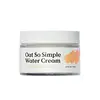What's inside
What's inside
 Key Ingredients
Key Ingredients

No key ingredients
 Benefits
Benefits

 Concerns
Concerns

No concerns
 Ingredients Side-by-side
Ingredients Side-by-side

Water
Skin ConditioningDisodium EDTA
Allantoin
Skin ConditioningBetaine
HumectantPanthenol
Skin ConditioningPantolactone
HumectantGlycerin
HumectantPropanediol
SolventButylene Glycol
Humectant1,2-Hexanediol
Skin ConditioningSodium Hyaluronate
HumectantCetearyl Olivate
Sorbitan Olivate
EmulsifyingSodium Stearoyl Glutamate
CleansingHydroxyethyl Acrylate/Sodium Acryloyldimethyl Taurate Copolymer
Emulsion StabilisingSorbitan Isostearate
EmulsifyingXanthan Gum
EmulsifyingCetearyl Alcohol
EmollientCetearyl Glucoside
EmulsifyingGlucose
HumectantC14-22 Alcohols
Emulsion StabilisingC12-20 Alkyl Glucoside
EmulsifyingButyrospermum Parkii Butter
Skin ConditioningButylene Glycol Dicaprylate/Dicaprate
EmollientPentaerythrityl Tetraethylhexanoate
EmollientSqualane
EmollientCaprylic/Capric Triglyceride
MaskingBixa Orellana Seed Oil
EmollientHelianthus Annuus Seed Oil
EmollientGlycine Soja Oil
EmollientTocopherol
AntioxidantEthylhexylglycerin
Skin ConditioningCeramide NP
Skin ConditioningPhytosphingosine
Skin ConditioningHydrogenated Lecithin
EmulsifyingGlyceryl Stearate
EmollientDipropylene Glycol
HumectantCeramide EOP
Skin ConditioningCeramide AP
Skin ConditioningOlea Europaea Fruit Oil
MaskingOryza Sativa Bran Oil
EmollientMorinda Citrifolia Seed Oil
Skin ConditioningMoringa Oleifera Seed Oil
EmollientMethyl Trimethicone
Skin ConditioningSodium Polyacryloyldimethyl Taurate
Emulsion StabilisingDicaprylyl Ether
EmollientPolyglyceryl-10 Dilaurate
Hedera Helix Extract
AntimicrobialBrassica Campestris Seed Oil
Skin ConditioningPolygonum Tinctorium Leaf Extract
Skin ConditioningParfum
MaskingWater, Disodium EDTA, Allantoin, Betaine, Panthenol, Pantolactone, Glycerin, Propanediol, Butylene Glycol, 1,2-Hexanediol, Sodium Hyaluronate, Cetearyl Olivate, Sorbitan Olivate, Sodium Stearoyl Glutamate, Hydroxyethyl Acrylate/Sodium Acryloyldimethyl Taurate Copolymer, Sorbitan Isostearate, Xanthan Gum, Cetearyl Alcohol, Cetearyl Glucoside, Glucose, C14-22 Alcohols, C12-20 Alkyl Glucoside, Butyrospermum Parkii Butter, Butylene Glycol Dicaprylate/Dicaprate, Pentaerythrityl Tetraethylhexanoate, Squalane, Caprylic/Capric Triglyceride, Bixa Orellana Seed Oil, Helianthus Annuus Seed Oil, Glycine Soja Oil, Tocopherol, Ethylhexylglycerin, Ceramide NP, Phytosphingosine, Hydrogenated Lecithin, Glyceryl Stearate, Dipropylene Glycol, Ceramide EOP, Ceramide AP, Olea Europaea Fruit Oil, Oryza Sativa Bran Oil, Morinda Citrifolia Seed Oil, Moringa Oleifera Seed Oil, Methyl Trimethicone, Sodium Polyacryloyldimethyl Taurate, Dicaprylyl Ether, Polyglyceryl-10 Dilaurate, Hedera Helix Extract, Brassica Campestris Seed Oil, Polygonum Tinctorium Leaf Extract, Parfum
 Reviews
Reviews

Ingredients Explained
These ingredients are found in both products.
Ingredients higher up in an ingredient list are typically present in a larger amount.
1,2-Hexanediol is a synthetic liquid and another multi-functional powerhouse.
It is a:
- Humectant, drawing moisture into the skin
- Emollient, helping to soften skin
- Solvent, dispersing and stabilizing formulas
- Preservative booster, enhancing the antimicrobial activity of other preservatives
Butylene Glycol (or BG) is used within cosmetic products for a few different reasons:
Overall, Butylene Glycol is a safe and well-rounded ingredient that works well with other ingredients.
Though this ingredient works well with most skin types, some people with sensitive skin may experience a reaction such as allergic rashes, closed comedones, or itchiness.
Learn more about Butylene GlycolThis ingredient is an emollient, solvent, and texture enhancer. It is considered a skin-softener by helping the skin prevent moisture loss.
It helps thicken a product's formula and makes it easier to spread by dissolving clumping compounds.
Caprylic Triglyceride is made by combining glycerin with coconut oil, forming a clear liquid.
While there is an assumption Caprylic Triglyceride can clog pores due to it being derived from coconut oil, there is no research supporting this.
Learn more about Caprylic/Capric TriglycerideSqualane is an emollient that helps the skin hold onto moisture. It's an oily liquid that occurs naturally in certain types of fish and plant oils.
Because squalane boosts hydration in the skin, it also comes with plenty of benefits: it is an antioxidant and can help fight free radicals and skin damage. Squalane is also found to have a detoxifying effect when applied.
Squalane comes from squalene, which occurs naturally within the sebum of our skin. It is one of the oils our skin produces to keep itself hydrated. Squalane is the hydrogenated version of squalene and has a longer shelf life.
Research shows that squalane is non-irritating (even at 100% concentration).
In general, it's a fantastic ingredient. It does a great job at hydrating the skin, and it's suitable for those with sensitive skin.
The source of squalane may impact malassezia / fungal acne. This is because olive oil derived squalane can contain impurities such as fatty acids and plant waxes. Sugarcane derived squalane is recommended for anyone with malassezia concerns.
Is squalane vegan?
This depends on the source. Squalane can be derived from both plants and animals. Most squalane used in skincare comes from plants.
Please note: the source of squalane is only known if disclosed by the brand. We recommend reaching out to the brand if you have any questions about their squalane.
Read more about squalene with an "e".
Is squalane an oil?
Squalane is often called an oil, but it’s technically not; it’s a hydrocarbon, meaning it’s only made of carbon and hydrogen, unlike true oils which are triglycerides made of fatty acids and glycerol.
The term “oil-free” isn’t regulated, so companies can define it however they want. Some exclude all oils, while others just avoid mineral oil or comedogenic oils.
While some people avoid oils thinking they cause breakouts, the right kind of oil (or oil-like ingredient like squalane) can actually help balance and hydrate your skin. It’s worth testing out simple oils or squalane to see what works best for your skin.
Learn more about SqualaneWater. It's the most common cosmetic ingredient of all. You'll usually see it at the top of ingredient lists, meaning that it makes up the largest part of the product.
So why is it so popular? Water most often acts as a solvent - this means that it helps dissolve other ingredients into the formulation.
You'll also recognize water as that liquid we all need to stay alive. If you see this, drink a glass of water. Stay hydrated!
Learn more about Water